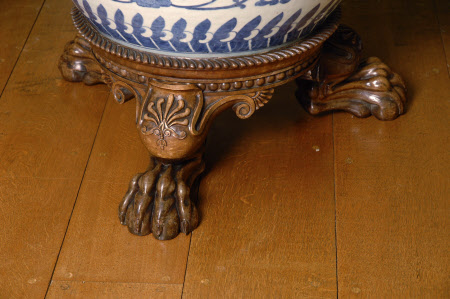Stand
manner of George Smith (London c.1786-1826)
Category
Furniture
Date
circa 1805 - 1810
Materials
Mahogany
Measurements
25 x 71 x 71 cm
Place of origin
London
Order this imageCollection
Kingston Lacy Estate, Dorset
NT 1254743.1
Summary
One of a pair of mahogany vase stands, after a design by George Smith (London c.1786-1826), London, circa 1805-10. Each of circular form with a gadrooned top edge and beaded moulded collar raised on three stylized lion's leg and paw supports carved with anthemion designs to the knees.
Full description
The stands with the exaggerated lion's paw and the anthemion carved knees display the influence and genius of the Regency designer George Smith. Smith’s work was widely distributed in his pattern book of 1808, ‘A Collection of Designs for Household Furniture and Interior Decoration’, in which he proudly declared himself the ’upholder extraordinary to his Royal Highness the Prince of Wales’. Contempary designers such as Thomas Hope and Charles Heathcote-Tatham also published drawings based on their tours and studies of ancient Greece and Rome. This 'antique style' became popular during the early years of the 19th century and was patronized by the highest of society. Plate 82 of his published work illustrates a 'dejuné table' 1805, the foot is oversized and draws all attention, a window seat in plate 41 emphasizes this also and the anthemion decoration appears on many of Smith's designs. See also plate 50 (B) a design for a footstool. George Smith was not a joiner , carver or cabinet maker, his designs, like Hope, Tatham and others were published for craftsmen to follow and for patrons to commission, therefore it is unlikely we shall ever know in who's workshop these stands were made. James Weedon (June 2018)
Provenance
Bequest of the estates of Corfe Castle and Kingston Lacy made to the National Trust by Henry John Ralph Bankes (1902-1981). NT ownership commenced from 19th August 1982.
Makers and roles
manner of George Smith (London c.1786-1826), designer
References
Smith, George 'A collection of Designs for Household Furniture' London 1808 Jourdain, Margaret,. Regency furniture 1795-1830 1965. Edwards & Macquoid (1986), P. Macquoid & R. Edwards, The Dictionary of English Furniture (1986)
